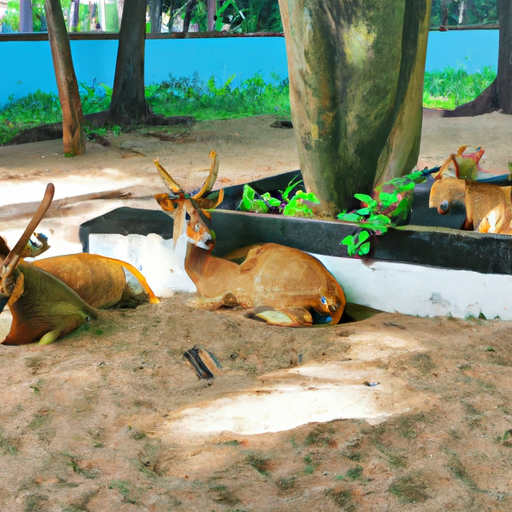 The term used to describe the location or facility where animals are kept, whether for exhibition, conservation, research, or other purposes, can vary depending on the context and intended purpose of the facility. Throughout history, humans have created various spaces and structures to house animals, often referred to as animal enclosures, habitats, pens, exhibits, or even zoological parks. In this article, we will dive into the diverse range of animal habitats and enclosures and explore their evolution over time.
The term used to describe the location or facility where animals are kept, whether for exhibition, conservation, research, or other purposes, can vary depending on the context and intended purpose of the facility. Throughout history, humans have created various spaces and structures to house animals, often referred to as animal enclosures, habitats, pens, exhibits, or even zoological parks. In this article, we will dive into the diverse range of animal habitats and enclosures and explore their evolution over time.
1. Animal Enclosures in Ancient Times:
From as early as ancient civilizations, humans have kept animals in captivity for different reasons. Ancient Egyptians, for example, constructed small enclosures known as menageries to house exotic animals, which were often seen as symbols of power and wealth. These menageries served as a form of entertainment and a display of prestige among the ruling elite.
Similarly, the ancient Greeks and Romans built zoos or “zoa” to exhibit animals, often acquired through trade or as spoils of war. These early zoos were primarily focused on showcasing wild and exotic creatures, providing educational and entertainment value to the spectators.
2. The Evolution of Menageries and Zoos:
As societies evolved and expanded, so did the concept of animal enclosures. During the Middle Ages, royal menageries became increasingly popular across Europe. Kings and nobles would collect animals from their own lands or receive them as gifts from foreign dignitaries. These menageries were lavish displays of wealth and power, and the animals were often held in small, rudimentary enclosures, lacking proper care and welfare considerations.
The 18th and 19th centuries marked a significant shift in attitudes towards animals. As scientific understanding improved, the focus shifted from mere spectacle to conservation and education. This period saw the emergence of modern zoos as we know them today, with larger enclosures and a greater emphasis on animal welfare and species conservation.
3. Modern Zoos and Animal Parks:
In the 20th century, zoos underwent a transformation to align with evolving ethical standards and scientific knowledge. The term “zoo” began to be replaced by more encompassing terms such as zoological parks, wildlife parks, or animal sanctuaries. These facilities aimed to provide a more naturalistic environment for animals while focusing on conservation efforts, research, and education.
Modern zoos and animal parks strive to recreate natural habitats to the best of their abilities. Enclosures are designed to cater to the specific needs of each species, incorporating features like trees, rocks, water bodies, and artificial landscapes. The goal is to provide animals with ample space, enrichment, and opportunities to engage in natural behaviors.
4. Specialized Animal Facilities:
Beyond traditional zoos, various specialized facilities exist to cater to specific animal needs. Aquariums, for instance, are dedicated to marine life, replicating underwater ecosystems and providing educational experiences about the world’s oceans and water bodies.
Aviaries are designed to house birds, providing them with large enclosures or free-flight exhibits that simulate their natural habitats. These facilities often focus on endangered or rare bird species, contributing to breeding programs and conservation efforts.
Similarly, wildlife rehabilitation centers and sanctuaries are dedicated to providing temporary or permanent homes for injured, orphaned, or confiscated animals. These facilities aim to rehabilitate animals and, if possible, reintroduce them to their natural habitats.
5. Ethical Considerations and Animal Welfare:
While the concept of keeping animals in captivity has evolved over time, ethical debates still surround the practice. Critics argue that confining animals for human entertainment compromises their freedom and quality of life. They advocate for alternatives, such as virtual reality experiences or observing animals in their natural habitats through responsible ecotourism.
However, proponents of well-managed zoos and animal facilities emphasize their crucial role in conservation, research, and education. Modern facilities dedicate significant resources to animal welfare, focusing on enrichment programs, veterinary care, and conservation breeding efforts. They provide opportunities for visitors to learn about animals, their habitats, and the importance of conservation.
In conclusion, the spaces and structures where animals are kept have undergone a remarkable transformation throughout history. From the early menageries of ancient civilizations to the modern zoos and specialized animal facilities of today, the focus has shifted from mere spectacle to conservation, education, and animal welfare. As our understanding of animals and their needs continues to grow, these facilities will undoubtedly evolve further to provide the best possible environments for the animals under their care.
